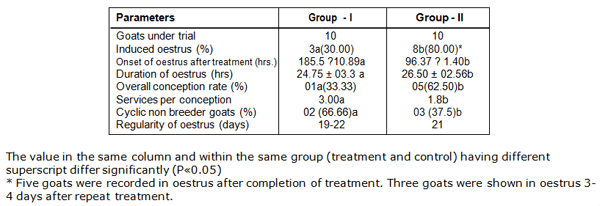Introduction
Osmanabadi goat is the most popular breed in Maharashtra, India and has best proliferative potential with three to five kids per term, animals maintained under improved managemental conditions have recorded highest fecundity. Goats are seasonal polyestrous and they naturally exhibit 70 per cent during July to August and 30 per cent shows in January to February. The season pattern of reproductive activity of the goat results in a lower reproductive efficacy i.e. delayed puberty, increasing inter-kidding interval, etc. and the seasonality of production leads to market price oscillations. The post-partum (PP) period is comprised of a series of integrated anatomic and physiologic re-adjustments of both the uterus and endocrine system, and is a crucial factor for the resumption of reproductive capacity and regular cycling of a breeding goat. Completion of uterine involution and resumption of sexual activity following parturition in ruminants normally depend on several factors, such as nutrition, nursing of offspring and season of parturition (Van Wyk et al., 1972; Delgadillo et al., 1998; Mwaanga and Janowski, 2000; Yavas and Walton, 2000). Hence, the study was undertaken as a research trial on animals with the history of post- partum anestrous for and its treatment with polyherbal estrous inducer formulation Janova.
Materials and Methods
The research was carried out on 20 Osmanabadi goats belonging to Goat farm unit, College of Veterinary & Animal Sciences Udgir, Maharashtra, India during the period from December 2008 to March, 2009. All goats were selected only after 60 days of kidding. Optimum health score conditions and managemental care were confirmed in each animal before including the case under trial. These animals were approximately of same age and nutritional health status with the history of post-partum anestrus and anestrous. Goats were given a detailed gynecological examination for confirmed diagnosis of post partum anestrus and were divided into two groups I and II, (n=10). Group-I animals were not given any treatment and served as control group. Treatment group II animals were administered orally with capsule Janova@2 cap/day/goat for three days. The total experiemental duration was 150 days in order to record the observations on post treatment estrus induction, conception rate and nature of discharge. The data was analyzed by using Completely Randomized Design (unequal) as per Sendecor and Cochran (1967).
Results and Discussion
Results of present experiemental study are summarized in table No.1. The goats of treatment group II were treated with the triple approach of treatment responded 80 % success of induced oestrus within 96.37+1.40 hrs after treatment which was significantly higher than untreated control group (30%).Five goats were recorded in oestrus whereas three goats were induced heat within 3-4 days after repeat treatment after 14 days. Average duration of oestrus was also significantly higher in treated goats (26.50 ± 02.56 hrs) than control (24.75 +03.37 hrs). The type of oestrus was of intermediate in treatment and control group. In group II, Eight goats (80%) conceived with 1.8 services per conceptions and one goat remained cyclic non-breeder. In contrast, in untreated control group I, three goats were concieved with three services per conception, conception rate was recorded to be 33.33% and estrus was induced within 185.5 + 10.89hrs. The regularity of post partum oestrus cycle was observed after every 21 days in treatment group. The significant improvement in fertility & estrus induction in goats may be attributed to the constituent herbs of polyherbal heat inducer Janova viz; Citrullus collocynthus, Piper longum, Piper nigrum and Zingiber officinale scientifically well known to exert gonadotropin like action and synchronizing the release of physiological hormones (FSH, LH and estradiol) for induction of ovulatory estrous (Srivastava, 1997). Feeding of Janova appears to stimulate the hypothalamo-hyposeal-ovarian axis thereby synchronizing the hormonal release & inducing estrous in early post-partum anestrous period with comparatively higher conception rate (Singal, 1995). Induction of fertile post partum oestrus & higher conception rate in Osmanabadi goats was found to be effective with Janova administration. It may be concluded that herbal heat inducer therapy is effective in induction of post partum oestrus and the induced ovulatory oestrus can suitably improve conception rate in small ruminants.
Table 1. Response of herbal drugs and mineral supplementations in Osmanabadi goats
References
1. Delgadillo, J. A., J. A. Flores, M. J. Villareal, G. Hoyos, P. Chemineau and B. Malpaux (1998). Length of postpartum anestrous in goats in subtropical Mexico: effect of season of parturition and duration of nursing. Theriogenology 49: 1209-1218.
2. Mwaanga E. S. and Janowski, T. (2000). Anoestrus in dairy cows: cause, prevalence and clinical forms. Reprod. Dom. Anim., 35: 193-200.
3. Snedecor, G.W. and Cochran, W.G. (1967). Statistical methods 6th edn. The Iowa state university press Ames, Iowa, USA.
4. Srivastava, E.1.C. (1997) Role of Exapar and Janova in the pos parturient anoestrus in bovines. Indian Vet. Med. Jour., 21: 231-232.
5. Van Wyk, L. C., C. H. Van Niekerk and P. C. Belonje (1972). Further observations on the involution of the postpartum uterus of the ewe. J. South African Vet. Ass., 43: 29-33.
6. Yavas Y. and Walton, J. S. (2000). Postpartum acyclicity in suckled beef cows: A review.Theriogenology, 54: 25-55.
This article was originally published in Vet World. 2010; 3(6): 293-294.






.jpg&w=3840&q=75)